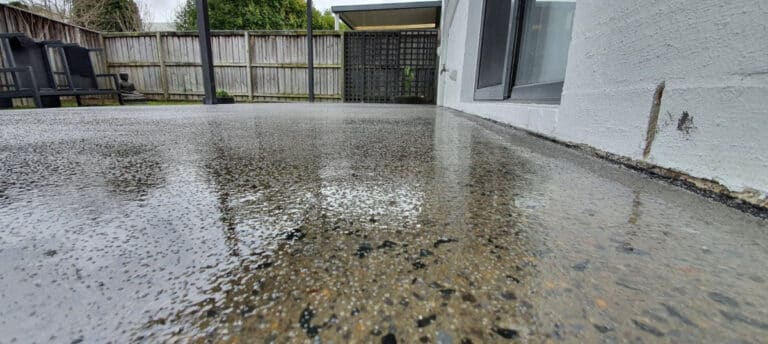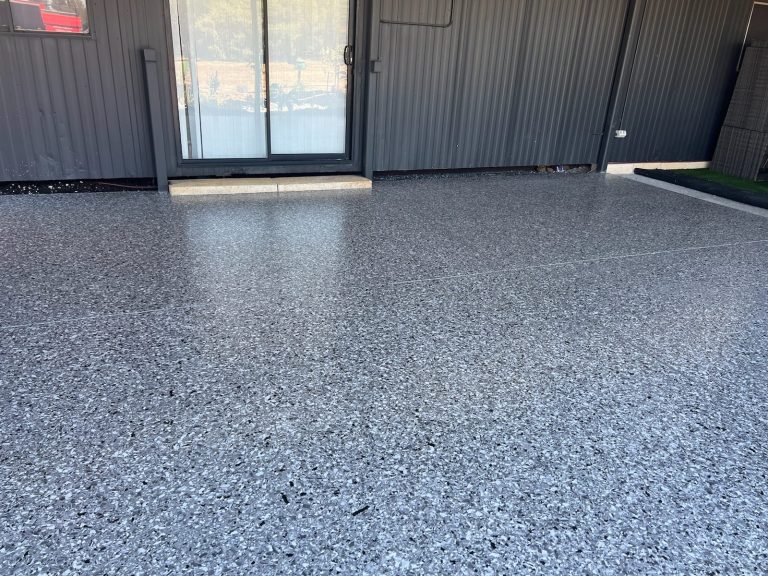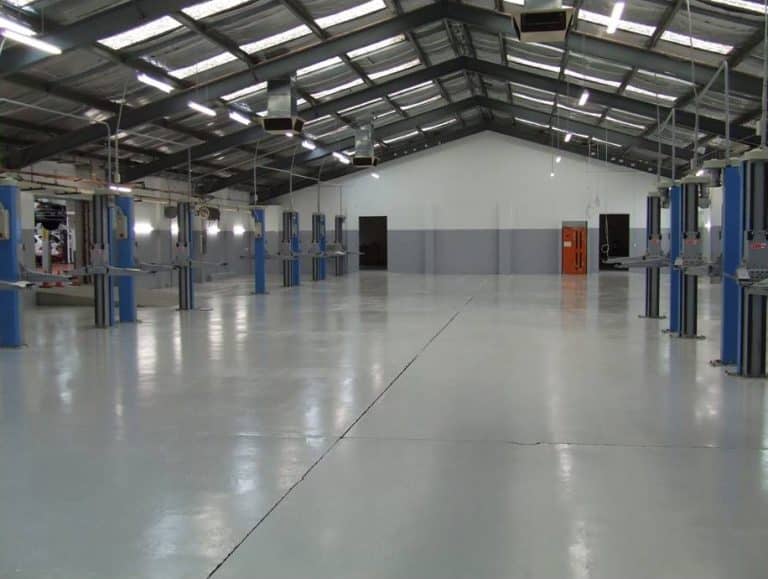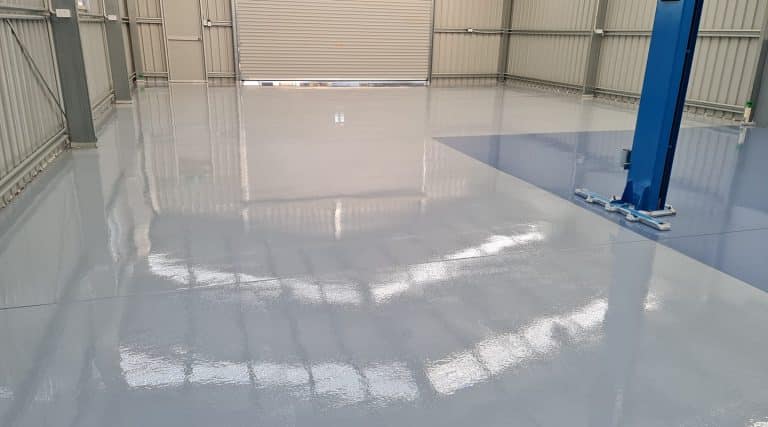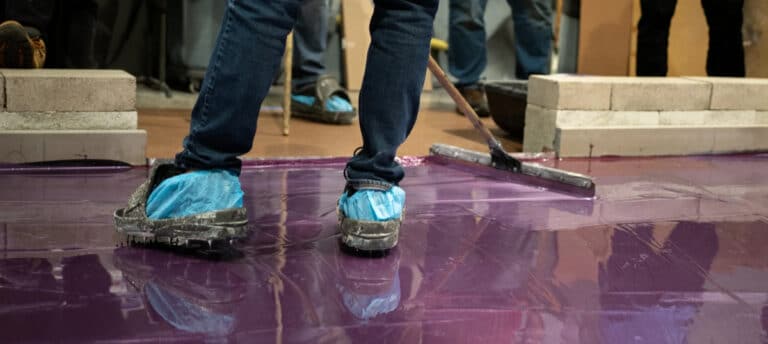How to Make Epoxy Flooring Less Slippery: The Simple Guide
A slippery epoxy floor is more than an inconvenience—it’s a serious safety hazard.
Whether it’s in a warehouse, showroom, or retail space, a slick surface increases the risk of slips, falls, and potential liability issues.
Epoxy flooring is widely used for its durability, seamless finish, and aesthetic appeal. However, when not properly treated or maintained, it can become dangerously slippery, especially when exposed to moisture, dust, or spills.
This guide will walk you through the best methods to fix slippery epoxy floors, from choosing the right additives to surface treatments and regular maintenance practices.
We’ll cover important considerations, step-by-step solutions, and expert tips to help you achieve a safer, more durable surface.
| There are multiple solutions to improve slip resistance, including anti-slip additives, coatings, etching, and mechanical treatments. |
Epoxy Flooring Overview
Epoxy flooring is a highly durable and versatile flooring solution commonly used in commercial and industrial spaces.
It consists of a resin and hardener that, when combined, creates a strong, seamless surface resistant to chemicals, stains, and heavy foot traffic.
Epoxy is an excellent choice for warehouses, retail stores, showrooms, and offices looking for both functionality and aesthetics. Unlike traditional concrete or tile floors, epoxy coatings can withstand wear and tear for years with minimal maintenance.
Epoxy solutions also provide a sleek, polished finish that enhances the overall appearance of a space, making it look clean and professional.
However, while epoxy flooring offers many benefits, it can become slippery—especially when wet or contaminated with dust and oils.
To maintain a safe environment, businesses need to implement effective anti-slip measures, ensuring employees and customers can move around without risk.
Safety, Sustainability, and Compliance
Environmental Impact
Epoxy coatings contain chemicals that, if not managed correctly, can release volatile organic compounds (VOCs) into the air.
While modern formulations have significantly reduced VOC content, businesses should still opt for low-VOC or water-based epoxy products to minimise environmental harm.
Additionally, some anti-slip additives—such as silica, polymer beads, or aluminium oxide—are more eco-friendly than others.
Choosing sustainable materials can help reduce waste and improve indoor air quality, making the workspace safer for employees and visitors.
Necessary Permits and Inspections
In Perth, commercial properties may require permits or inspections when modifying flooring, especially in high-traffic areas or industries with strict safety regulations, such as hospitality, healthcare, or manufacturing.
Businesses should check with local authorities or workplace safety regulators to ensure compliance with anti-slip standards.
Australian Standards, such as AS 4586 (Slip Resistance Classification of New Pedestrian Surface Materials), provide guidelines for assessing and maintaining slip resistance in commercial environments.
Regular inspections and compliance checks can help businesses avoid potential fines and liability risks.
Assessing Your Space: What You Need to Fix a Slippery Epoxy Floor
Understanding Your Flooring Needs
Each commercial space has specific flooring needs based on foot traffic, exposure to moisture, and industry standards. Identifying these factors will help determine the best anti-slip solution.
Traffic and Usage Considerations
- High-Traffic Areas: Warehouses, retail spaces, and office buildings require durable, long-lasting anti-slip solutions to withstand constant movement.
- Light-Traffic Areas: Spaces with less foot traffic, such as storage rooms or private offices, may need only minimal surface modifications.
Exposure to Moisture and Spills
- Wet Environments: Businesses such as commercial kitchens, car showrooms, or workshops where water, oil, or chemicals are frequently spilled require high-grip solutions.
- Dry Environments: Offices or retail spaces with minimal exposure to moisture may only need slight surface adjustments to improve traction.
Essential Tools and Resources
Fixing a slippery epoxy floor requires the right tools and materials to ensure an effective and lasting solution. Depending on the chosen method, some common resources include:
Basic Tools
- Industrial degreasers and cleaners
- High-quality rollers or brushes for coatings
- Non-slip additives such as silica sand, polymer beads, or aluminium oxide
- Concrete etching solutions (if surface texture needs improvement)
Professional vs DIY Solutions
When to DIY
- If only minor adjustments are needed, such as adding a non-slip matting or cleaning buildup
- When applying non-slip coatings to small areas with minimal risk
When to Hire Professionals
- For large-scale flooring modifications that require precise application
- If compliance with Australian safety standards needs verification
- When using specialised materials that require expert handling
Choosing the Right Components to Fix a Slippery Epoxy Floor
Anti-Slip Additives for Epoxy Coatings
Anti-slip additives are mixed directly into the epoxy topcoat or broadcasted onto the surface to create additional texture.
Types of Anti-Slip Additives
- Silica Sand – An affordable and effective option that provides moderate traction. Best suited for light-to-medium traffic areas.
- Aluminium Oxide – A highly durable material that offers excellent slip resistance, commonly used in industrial environments.
- Polymer Beads – These create a subtle texture while maintaining the epoxy’s glossy appearance, making them ideal for retail and office spaces.
- Crushed Glass – A heavy-duty option for extreme traction needs, though it may alter the aesthetics of the flooring.
Non-Slip Mats and Coatings
For areas where adding grit to epoxy isn’t an option, non-slip mats and coatings can provide an alternative solution.
Non-Slip Mats
- Rubber Mats with Traction Patterns – Ideal for high-risk areas like entryways and wet zones.
- Interlocking Anti-Fatigue Mats – Great for workplaces where employees stand for long periods.
Non-Slip Coatings
- GripX Clear Anti-Slip Coating – A transparent option that works well in commercial spaces needing an invisible traction boost.
- SlipDoctors Floor Grip – A roll-on solution designed for epoxy, tile, and other smooth surfaces.
Surface Etching and Mechanical Treatments
In cases where the epoxy surface is too smooth, etching or mechanical treatments can help create a more textured finish.
Concrete Etching Solutions
- Hydrochloric Acid (Muriatic Acid) – A common solution for roughening surfaces before applying a new anti-slip coating.
- Eco-Etch Pro – A biodegradable etching product that is safer to use and environmentally friendly.
Mechanical Treatments
- Diamond Grinding – A professional method for lightly roughening the epoxy surface without damaging its integrity.
- Shot Blasting – Suitable for heavily trafficked industrial floors needing extreme traction improvements.
Step-by-Step Guide to Fixing Your Slippery Epoxy Surfaces
Step 1: Prepare the Floor for Treatment
Before applying any anti-slip solution, the epoxy surface must be thoroughly cleaned and assessed for any damage.
Cleaning the Surface
- Remove all dust, dirt, and grease using an industrial degreaser or a mild detergent.
- Use a mop, scrub brush, or pressure washer for deep cleaning.
- Let the floor dry completely before proceeding.
Checking for Existing Damage
- Inspect for cracks, peeling, or uneven areas in the epoxy coating.
- If damage is found, repair it with an epoxy patching compound before continuing.
Step 2: Choose the Right Anti-Slip Method
Depending on your flooring needs, select the most suitable anti-slip solution.
Adding an Anti-Slip Additive to Epoxy
- If applying a new epoxy topcoat, mix the chosen non-slip additive directly into the resin.
- Stir thoroughly to ensure even distribution.
- Apply the mixture using a roller or brush, following the manufacturer’s guidelines.
Broadcasting Additive on an Existing Epoxy Floor
- Lightly sand the surface to create a better bond.
- Apply a fresh clear epoxy or polyurethane coat.
- Evenly distribute the anti-slip additive by lightly sprinkling it onto the wet coating.
- Allow it to settle, then roll another thin topcoat to lock it in place.
Applying a Non-Slip Coating
- Choose a suitable roll-on or spray-on non-slip treatment.
- Apply it evenly using a roller, taking care not to leave streaks or bubbles.
- Allow proper curing time as specified by the manufacturer.
Step 3: Allow for Proper Curing and Drying
After application, give the floor ample time to dry and cure before resuming foot traffic.
- Check the product instructions for drying times—some coatings require 24 to 48 hours to fully cure.
- Avoid heavy machinery or water exposure during the curing period.
- Conduct a slip test once the surface is dry to confirm improved traction.
Step 4: Implement Regular Maintenance Practices
Maintaining a slip-resistant epoxy floor ensures long-term safety and durability.
- Clean regularly with non-abrasive cleaners to prevent dirt buildup.
- Reapply non-slip treatments as needed, especially in high-traffic areas.
- Conduct periodic slip resistance testing to ensure ongoing compliance with safety standards.
When to Call a Professional Installer
While minor anti-slip treatments can be done as a DIY project, some installation projects require professional expertise.
Signs You Need Professional Help
- The epoxy coating is significantly damaged or peeling.
- The floor is in a high-risk area where strict safety standards apply.
- Advanced surface treatments, such as shot blasting or diamond grinding, are needed.
- Previous DIY attempts did not improve traction effectively.
Hiring a professional ensures compliance with Australian slip resistance standards and provides a more durable solution for commercial spaces.
How Much Will an Epoxy Flooring Project Cost?
| Component | Estimated Cost |
| Materials | |
| – Epoxy Coating | $30 – $100 per litre |
| – Anti-Slip Additives | $10 – $50 per kg |
| Labour | |
| – Professional Installation | $50 – $100 per hour |
| Surface Preparation | |
| – Cleaning and Repairs | $5 – $15 per m² |
| – Surface Profiling | $10 – $20 per m² |
| Additional Costs | |
| – Equipment Rental | $100 – $300 per day |
| – Safety Gear | $50 – $150 |
Please Note: These figures are approximate and can vary based on specific project requirements and market conditions.
Get Expert Advice on Your Epoxy Flooring Solution
Don’t let a slippery floor put your business, reputation or safety at risk. Whether you need expert recommendations, high-quality materials, or professional installation, PM Industries is here to help.
Our team specialises in custom, non-slip epoxy flooring solutions tailored to your specific business needs. From warehouses to retail spaces, we ensure your flooring is safe, compliant, and built to last.
Transform your space with epoxy that lasts a lifetime — Contact PM Industries now at 0436 837 699 or claim your fast and FREE quote online to save time!


